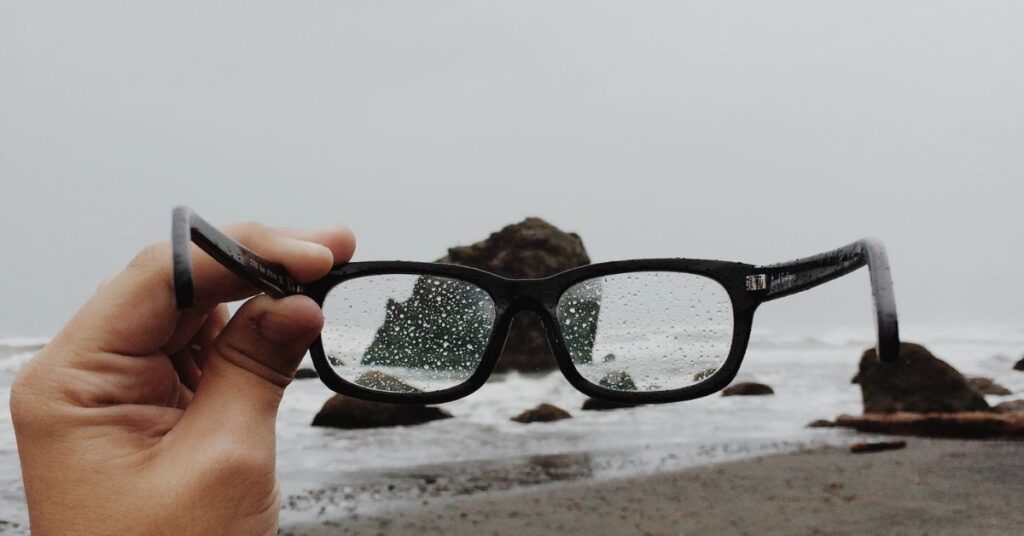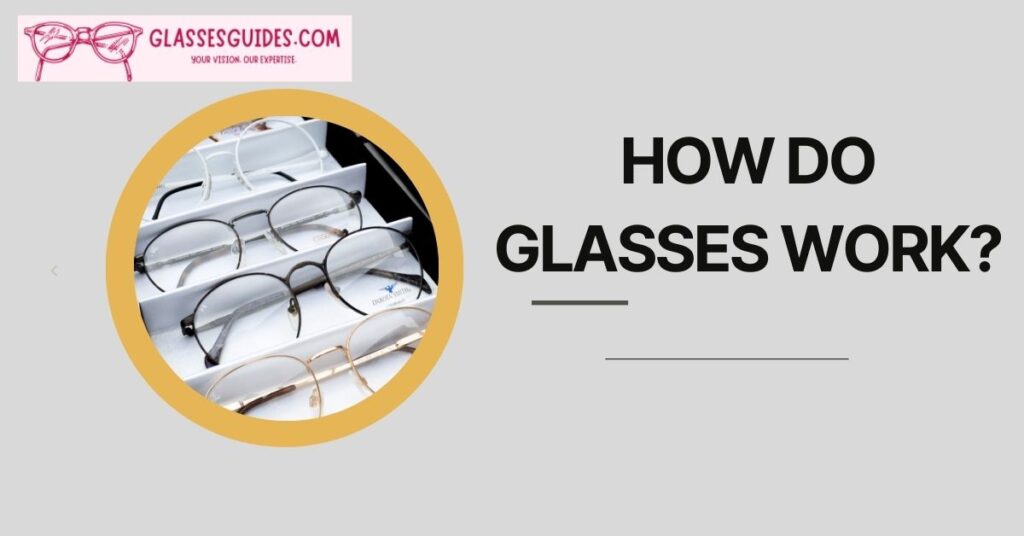Greetings from the exciting world of eyeglasses, where fashion and science combine to improve eyesight! Ever ponder How do glasses work? These stylish add-ons are clever tools that adjust our perception of reality, not merely fashion items. Imagine this: little wonders that sit atop your nose and change the direction of light to provide clear, sharp vision.
We’ll explore the optical mysteries of glasses in this quick tour, including how they can be used to rectify refractive problems and serve as your window to a clearer, more colorful world. So buckle up, because we’re about to go on an enthralling journey into the magical world of eyewear!
Table of Contents
Purpose of glasses
The purpose of glasses extends beyond mere vision correction; they alleviate eye strain, enhance clarity, and improve overall visual comfort. Whether for reading, driving, or daily activities, glasses play a crucial role in optimizing eyesight and contributing to a better quality of life.
Overview of the eye structure

The eye, a marvel of biological engineering, comprises several intricately interconnected structures that work harmoniously to facilitate vision. At the forefront is the cornea, a transparent outer layer that refracts incoming light. Behind it, the aqueous humor nourishes the lens, another essential refractive component. The iris, with its adjustable aperture (pupil), regulates the amount of light entering. The light then traverses the crystalline lens, fine-tuning focus.
The journey concludes at the retina, where photoreceptor cells convert light into electrical signals, transmitted to the brain via the optic nerve. This remarkable interplay between cornea, lens, iris, and retina transforms light into the rich tapestry of visual experiences we perceive daily.
Common vision problems

Here are the Common vision problems
1: Nearsightedness
Nearsightedness, or myopia, is a common vision problem where distant objects appear blurred while close ones remain clear. It occurs when the eyeball is too long or the cornea is too curved, causing light to focus in front of the retina instead of on it. Corrective lenses, like glasses or contact lenses, aid in refocusing light for clearer distance vision.
2: Presbyopia
Presbyopia is an age-related vision condition affecting the eye’s ability to focus on close objects. Typically emerging around middle age, it results from the natural stiffening of the eye’s lens, reducing its flexibility. Reading or performing close-up tasks becomes challenging. Bifocals or reading glasses are common solutions, providing clear vision for close-up activities.
3: Farsightedness
Farsightedness, or hyperopia, is a vision condition where close-up objects appear blurry, while distant ones remain clearer. This occurs when the eyeball is too short or the cornea has insufficient curvature, causing light to focus behind the retina. Corrective lenses, such as glasses or contact lenses, assist in redirecting light for improved close-up vision.
4: Astigmatism
Astigmatism is a common vision issue resulting from an irregular corneal or lens curvature, causing distorted or blurred vision. Light entering the eye fails to focus evenly on the retina, leading to a blurred image. Corrective lenses, like glasses or contact lenses, are prescribed to compensate for the uneven curvature and restore clear vision.
Further reading: How to fix scratches on glasses?
Explanation of how light enters the eye
Picture the eye as a complex camera capturing the world in vivid detail. When you gaze at an object, light from that object enters the eye through the transparent front cover called the cornea. Think of the cornea as the lens cap, protecting the delicate inner workings.
Next, the pupil—the eye’s movable aperture—allows light to enter, functioning similarly to the aperture settings on a camera. This process is controlled by the iris, the colorful portion of the eye, which changes the pupil’s size to control the quantity of light entering the eye. It’s like having a built-in dimmer switch, that responds to varied lighting circumstances.
Consider your eye’s lens as a dynamic focusing mechanism now. This lens works similarly to a camera lens that is zooming in or out by bending and flexing to adjust the incoming light. This important phase makes sure that light hits your retina at the back of your eye accurately.
The retina is where the magic happens. It’s covered in millions of tiny light-sensitive cells, photoreceptors, that convert the incoming light into electrical signals. These signals are then transmitted through the optic nerve to your brain, where they’re interpreted into the rich visual experiences you encounter daily.
So, the next time you marvel at the vibrant sunset or read a captivating book, remember this intricate dance of light within your eyes, turning the world into a mesmerizing tapestry of colors and shapes.
Role of the cornea and lens in bending light
Your eyes’ cornea and lens work together to bend light so that you may see clearly. The cornea bends incoming light, much like a clean window. Think of it like the front lens of a camera.
Next is the internal lens of your eye, which adjusts focus. Because of its flexibility, it may change form to direct light directly onto the retina, the back of the eye. Your ability to perceive the world around you with clarity and precision is made possible by the cooperation of your cornea and lens.
Further reading: How To Find My Glasses?
Vision Correction with Glasses
Glasses are like superheroes for your eyes, swooping in to rescue your vision and make the world crystal clear.
Here’s how they work their magic:
Convex and Concave Lenses
Glasses come with special lenses – some are convex, like a gentle outward curve, and others are concave, with a slight inward curve. It’s like having tiny wizards in your frames, shaping the way light travels through.
Focusing Light onto the Retina
The main mission of glasses is to guide light to the right spot – your retina. It’s as if they’re expert traffic directors, making sure each ray of light hits its mark, allowing you to see things in sharp focus.
Addressing Specific Vision Issues
Glasses are personalized problem-solvers. Whether you’re nearsighted, farsighted, or dealing with astigmatism, these trusty accessories are crafted to tackle your specific vision quirks. It’s like having a customized roadmap to clear sight, just for you.
Eye examination and prescription
Getting your eyes checked is like giving them a spa day. During an eye exam, an eye doctor checks how well your eyes work together and their overall health. If your vision needs a boost, they’ll prescribe glasses with specific numbers, almost like a secret code.
Wearing these glasses is like having a tailored roadmap for your eyes, guiding them to see the world with precision. So, don’t skip those eye check-ups – your eyes will thank you for the VIP treatment!
Types of Lenses Prescribed
- Single Vision Lenses: Ideal for correcting nearsightedness or farsightedness, providing clear vision at a specific distance.
- Bifocal Lenses: Two prescriptions in one lens, addressing both near and far vision needs, often used by individuals with presbyopia.
- Trifocal Lenses: Like bifocals but with an added intermediate prescription, catering to various distances.
- Progressive Lenses: Multifocal lenses without visible lines, offering a seamless transition between near, intermediate, and distance vision.
- Photochromic Lenses: Lenses that adapt to light conditions, darkening outdoors and lightening indoors.
- Anti-Reflective Coating: Reduces glare and reflections, enhancing clarity and reducing eye strain.
- High-Index Lenses: Thinner and lighter, suitable for stronger prescriptions.
- Polycarbonate Lenses: Impact-resistant and lightweight, providing added safety.

Care and Maintenance
Taking care of your glasses is like giving them a spa day – it ensures they keep pampering your eyes for the long haul.
Here’s how to keep them in top-notch condition:
- Cleaning Glasses Properly: Gentle is the key. Use a lens cleaning solution and a microfiber cloth to wipe away fingerprints and smudges. Avoid using abrasive materials that could scratch the lenses, keeping your view consistently crystal clear.
- Protecting Glasses from Damage: Treat your glasses like a prized possession. When not in use, store them in a protective case. Avoid placing them face down, and never leave them in direct sunlight or extreme temperatures. It’s like giving your glasses their own cozy nest.
- Regular Eye Check-ups for Prescription Updates: Just as we get older, our eyes change too. Regular eye check-ups are like updating your glasses’ navigation system. It ensures your prescription stays on point, letting you see the world with the clarity you deserve.
Benefits of Vision Correction
- Sharper Vision: Vision correction, like wearing glasses, ensures you see the world with enhanced clarity and sharpness.
- Reduced Eye Strain: Proper correction minimizes eye strain, making activities like reading or using digital devices more comfortable.
- Improved Safety: Clear vision is crucial for tasks like driving, reducing the risk of accidents and ensuring your safety.
- Enhanced Productivity: Correcting vision issues allows you to perform daily tasks more efficiently, boosting overall productivity.
- Better Quality of Life: Whether enjoying hobbies or appreciating the beauty around you, vision correction contributes to a richer and more enjoyable life.
Conclusion
We have looked at the delicate workings of the eye and the enchantment of spectacles in this fascinating voyage through the world of vision. Our eyes are amazing tools, from diagnosing common vision issues to mastering the art of vision correction. Personalized prescriptions, routine eye exams, and appropriate maintenance keep our windows to the outside world clear.
When we embrace the advantages of vision correction, we find a safer and more fulfilling way of life in addition to improved eyesight. So let’s honor the wonder of our eyes, value the clarity that glasses offer, and keep seeing the world’s brilliant splendor.
Frequently Asked Questions
How often should I get my eyes checked?
Ideally, have an eye exam every two years. However, if you experience changes in vision or eye discomfort, consult an eye care professional promptly.
Can I use someone else’s glasses in an emergency?
It’s not recommended. Prescription glasses are personalized. Wearing someone else’s may cause discomfort or even worsen your vision.
Are online eye exams reliable?
Online exams may be convenient but aren’t a substitute for comprehensive eye exams by professionals. Regular check-ups ensure accurate prescriptions and detect potential issues.
Do children need regular eye check-ups?
Yes, children should have regular eye exams to detect and address vision issues early, ensuring proper development.



